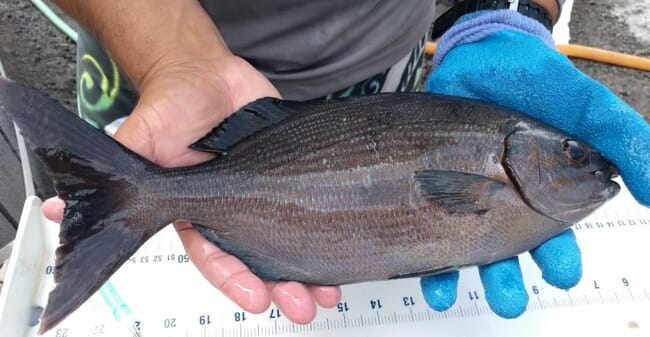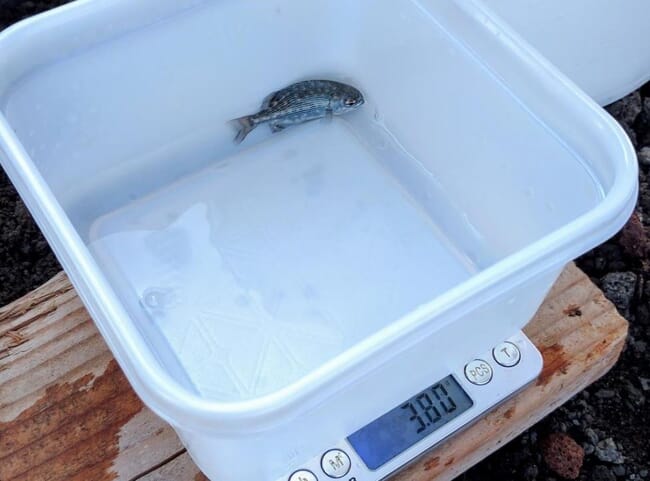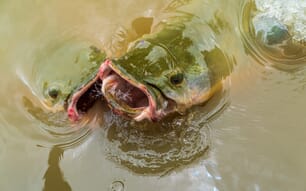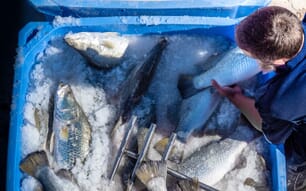
K. sectatrix is a type of kyphosid, a herbivorous tropical fish that may be suitable for aquaculture © Munoz et al. 2012, CC License 4.0
Dozens of finfish species are currently farmed in marine environments all around the world. However, most are subject to one of the major criticisms of marine aquaculture: the need for large quantities of fish meal and fish oil in formulated diets. To date, virtually all marine finfish evaluated for production have been carnivores (although when under duress some might qualify as omnivores). From salmon to cobia farming, substituting alternative ingredients in place of traditional feedstuffs is currently a primary research focus for industry development, and some progress is being achieved.
A number of years ago, when discussing the Fish In – Fish Out (FIFO) conundrum at a conference, a wise man asked why we don’t just focus on farming delicious vegetarian fish. To this day, many aquaculturists might respond that, just like unicorns, no such animal exists. But that isn’t true. To put things in perspective, the most cultured fish on the planet is in fact a herbivore. In the most recent State of World Fisheries and Aquaculture the FAO (2022) reports that in 2020 some 5.79 million tonnes of herbivorous grass carp were produced, while the fish with the next highest production total was (the omnivorous) tilapia at 5.48 million tonnes. By comparison, the most-produced carnivorous fish was Atlantic salmon, at 2.72 million tonnes that year.
Nonetheless, apart from grass carp, pacu or a few filter feeding species such as silver carp or gizzard shad, you rarely hear mention of herbivorous fishes suitable for aquaculture, especially in discussions relating to marine farming. But they’re out there. In recent years, an alternative to traditional marine species has emerged, albeit ever so quietly. Known commonly as rudderfish, drummers and chubs, these kyphosids fishes are widely consumed in many countries throughout Asia, the Middle East and Latin America (Moore 1962). Kyphosids as a group have been of interest to marine ecologists for decades because of their key trophic roles in tropical and temperate habitats.

Kyphosids are widely consumed in many countries throughout Asia, the Middle East and Latin America © Ocean Era, CC License 3.0
Kyphosids like to eat macroalgae. In fact, they were made to eat it. They possess highly specialised digestive tracts and hindguts and rely on ruminant-like gastrointestinal fermentation for digestion (Rimmer and Wiebe 1987, Skea et al. 2005, White et al. 2010). This unique digestive physiology positions kyphosids as ideal candidates for aquaculture development, based on their potential to utilise sustainable, low-cost, plant-based diets.
In addition to other related genera, some 18 species of Kyphosus are found in tropical and temperate waters throughout the world. Perhaps the most wide-ranging of these are the Bermuda chub (K. sectatrix) and the brassy chub (K. vaigiensis). Both are non-aggressive, schooling species. In the Gulf of Mexico the Bermuda chub is regularly seen at small drilling platforms in 6-15 metres of water, at sizes between 15 and 30 cm. Larger fish are often observed shoaling near the surface of larger platforms further offshore in 30 m of water. The brassy chub, however, is often observed much closer to shore.
These species are often found together throughout their ranges, in places as diverse as the Mediterranean, the coasts of Africa, many of the Pacific Islands, and in Central American waters. Both have many additional common names as a result of their global occurrence, and my favourite is probably “nenue”, the common name for K. vaigiensis and other chub species in Hawaii.

Kyphosus species may be suitable for aquaculture because they feed on macroalgae, are non-aggressive and naturally school © Terry Lilley
Nenue have long been esteemed in Hawaiian cuisine, and were once found in many of the ancient tidal ponds, or loko i‘a, on the archipelago. The species has a number of uses, not the least of which is in poke dishes. In the shallow waters around Hawaii’s coasts, nenue often approach the shore in large schools. And while these fish are uniformly greyish-bronze in color, on very rare occasions bright yellow individuals are observed. Valencia-Mendez et al. (2018) also reported yellow and pure white K. sectatrix individuals in the waters off Clarion Island in Mexico.
Native Hawaiians revered these brilliantly colored yellow fish (and still do), and referred to them as queen nenue. The ultimate goal of this admiration was to garner the queen’s favour so she would lead her subjects to the fishermen’s spears and nets. The yellow colouration has been attributed by some to a recessive mutation, and if that is the case then the fish that make it to adulthood while avoiding predators probably deserve to be treated like royalty. However, there are accounts of normal coloured adult chub gradually turning yellow, so perhaps something analogous to Game of Thrones is going on in these populations.
The comparatively short history of kyphosid aquaculture actually began with nenue in Hawaii. Neil Sims, CEO of the Hawaii-based mariculture company, Ocean Era, is the wise man I referred to previously. For almost two decades, Ocean Era and its predecessors have been conducting trials with the brassy chub. Several years ago, a company spokesperson made the case for nenue culture on Ocean Era’s blog, stating: “Herbivorous fish offer the opportunity for aquaculture to not just grow fish, but also grow the feed for the fish, potentially without reliance on wild-caught forage fish or terrestrial protein and oils. It could be a great opportunity for fish farm expansion, particularly for small-scale farms in less-developed countries.”
In 2017, Sims and his team reported on the first spawning of captive-reared kyphosids, obtaining fertilised eggs from tank-raised K. vaigiensis. Work at Ocean Era has shown the species performs well on diets based on macroalgae and with more traditional feed ingredients such as corn and wheat. It has easily adapted to life in captivity, and controlled spawning is routine. Larvae are also hardy and adaptable, and exhibit good growth and survival in green water nursery tanks. In tank grow-out, fish grew from 100 g to 1 kg in 12 months. A separate, four-month, trial resulted in an FCR of 1.77.
If commercial production grows to the point where offshore cages are used for culture, trials to date suggest that external parasites will probably not be an issue for nenue and other kyphosids, due to the minute teeth lining the edges of their scales (Kampachi Farms 2018). And that’s good, because cage culture seems to suit many kyphosid species. Pitt et al. (1977) indicated that wild caught juvenile Kyphosus exhibited good health and grew well under cage culture conditions when stocked with gilthead sea bream and various local species in the Gulf of Aqaba. Accounts of kyphosids finding their way into marine cages and deciding to stick around have also been reported from Taiwan, Honduras and Hawaii.

Work at Ocean Era has shown the species performs well on diets based on macroalgae and with more traditional feed ingredients such as corn and wheat © Ocean Era
A number of other related species offer potential for plant-fed aquaculture. Muñoz et al. (2012) described exploratory trials involving broodstock conditioning, spawning and larval culture of Graus nigra in Chile. After acclimation and maturation, wild-caught broodstock spawned spontaneously. Eggs hatched after approximately 36 hours, with a hatching rate of roughly 60 percent. By day 30 post-hatching, survival averaged 12.1 percent. Larvae were initially fed enriched live feeds (rotifers until day 20, followed by Artemia nauplii). Microalgae (Isochrysis and Nannochloris) were also provided and maintained at 60,000 cells per ml. Weaning to artificial diets began on day 35 post-hatching and was completed by day 40. As a result of variable environmental factors and persistent problems with Vibrio, few juveniles survived beyond 50 days post-hatching, but the results were considered promising.
Some non-kyphosid marine finfish also offer the possibility of fermentation-based digestion, although many are intermediate in their capacity to utilise plants for nutrition. These include the genus Odax (Seeto et al. 1996, Skea et al. 2005). The greenbone butterfish, Odax pullus, is highly prized in New Zealand, commanding very good prices in the local market. Sturm and Horn (1998) described feeding, gut morphology and assimilation in the zebraperch, Hermosilla azurea, and found they could digest a variety of macroalgae, including brown algae that contain compounds which normally deter feeding by other marine herbivores.

This fish species is a non-kyphosid fish species that digests its food via enteric fermentation © I Colmber, CC license 4.0
Horn and Messer (1992) reviewed the digestive physiology of a number of herbivorous marine fishes and proposed four general types of digestive mechanisms, including fermentation. More recently, Pisaniello et al. (2022) provided insights into the compositions of bacterial communities in Kyphosus species. One caveat should be mentioned: fishes that are similar to cattle in their ability to digest plant material using microbial fermentation are also similar in their potential to generate significant amounts of methane in the process. But let’s focus on solving one problem at a time, right?
Helen Meigs, a former hatchery manager with Ocean Era and currently working at SemanticBits, eloquently summed up the rationale for investing time and money in kyphosid species on the Ocean Era blog.
“Legions of researchers are pursuing plant-based and alternative proteins that can suitably nourish those carnivorous fish the market so demands – a noble pursuit, yet an admittedly roundabout way to produce ‘low trophic’ species. The more direct way, the simpler way, is to culture natural marine herbivores. Not all marine herbivores are suited for the dinner table. And market favourites – such as ahi and snappers – are all beautiful food fish in their own right. However, if even a fraction of the restaurants selling salmon and ahi poke bowls today also offered nenue grown on herbivorous diets, the seas would be that much better for it,” she reflected.








